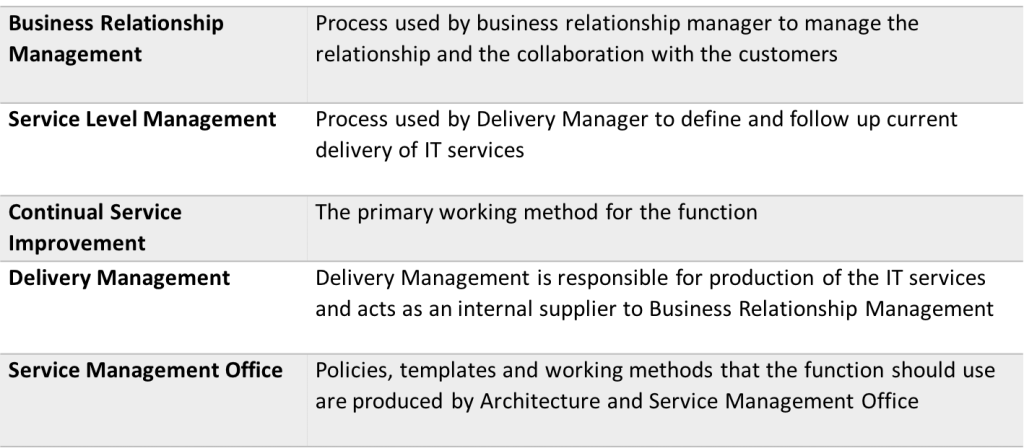The IT organization needs to have a business-like relationship with the business to enable it to govern the delivery of IT services according to the business’s needs. At the same time, the business needs to conduct its own analysis of the IT service’s value in relation to the cost.
Customer Management manages the contacts between the IT organization and the business. The function is located at the tactical level in the governance model and should focus on external efficiency (the business).

Purpose
The primary purpose of the Customer Management function is to understand the business’s requirements for IT and at the same time to create an understanding of the IT organization’s delivery.
A good relationship and a good climate facilitates collaboration with the business. With that in place, things become considerably easier on the day that IT does not deliver according to the agreed levels or fails with an installation.
The function also has the aim of keeping all deliveries to the business’s different customers together so that experiences and knowledge can be exchanged.

Responsibility
The function is the business’s primary contact point in relation to the IT department, and thus needs to take overall responsibility for all IT services that the business uses. In the same way that the Service Desk function is responsible for all communication with the users, Customer Management is responsible for all communication with customers and purchasers.
The responsibility also includes producing and documenting agreements regarding deliveries of IT services to the business. Meetings should be held with customers and purchasers where deliveries are followed up and new needs are investigated and prepared.
Activities and working method
There are several customer teams within the Customer Management function that are responsible for one or several customers in the business. A customer team consists of Business Relationship Manager and Delivery Manager, as well as one or several service owners.
Regular meetings take place within the customer team where the delivery of IT services to the specific customer is managed. Most businesses are under constant development, which means that the IT services needs to be continually adapted in order to meet the business’s requirements.
Responsibility is allocated within the customer team, with the Business Relationship Manager having overall responsibility for the customer and that the IT services provide a value to the business. The Business Relationship Manager also draws up the agreement with the customer where content and levels in the delivery are defined. The Delivery Manager is responsible for the agreed delivery to the customer and for contact with the customer’s purchaser.
The customers often want to have support from the IT department when it comes to discussing changes or needs that arise. Such meetings should have an open and creative atmosphere, with two colleagues within the same company together achieving an objective. On the other hand, a follow-up meeting at which statistics for the current delivery are reviewed easily becomes a meeting between a customer and a supplier. The atmosphere at such meetings can often be more accusatory and defensive than creative.
Through distinguishing between different roles and meetings with the customer, changes and forward-looking activities can be simply separated from follow-up of the current delivery. The Business Relationship Management and Service Level Management processes are used as support in this work.
Input
Inputs to the function consist primarily of requests and requirements from the customers. But also of reports, measurement data and proposals for improvement from the IT organization as a whole. The Continual Service Improvement process is used to structure all the issues which are received.
Output
The overall output from the function is the delivery of IT services to the business. More specifically, output consists of:
- Documentation of agreements
- Documentation of the customer’s planned activities and projects
- Improvement activities implemented
- New, changed requests for IT services to the Delivery Management function
- New requests to the service portfolio from the business
- Reports on customer satisfaction
- Knowledge about the business’s needs for strategy production
Documentation
All documents produced by the function must be available in a business system. The most important documents are:
- Agreements with the customers
- Documentation about the customer including:
- Contacts
- Purchaser
- Description of the business and how the IT services are used
- Activity plan per customer
- Budget per customer
Relationships with other processes and functions
Customer Management has links to many other processes and functions. The most common are listed here:


